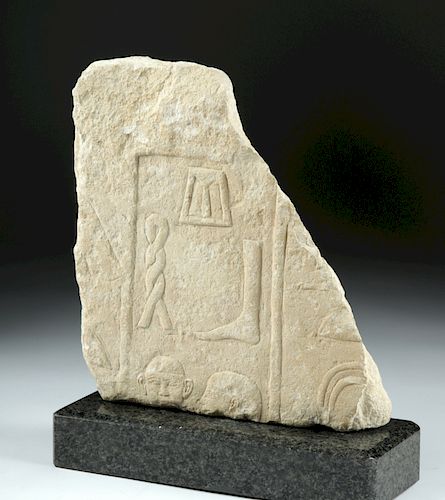Egyptian Old Kingdom Limestone Relief, ex-Bonhams
Lot 2
About Seller
Artemis Fine Arts
686 S Taylor Ave, Ste 106
Louisville, CO 80027
United States
Selling antiquities, ancient and ethnographic art online since 1993, Artemis Gallery specializes in Classical Antiquities (Egyptian, Greek, Roman, Near Eastern), Asian, Pre-Columbian, African / Tribal / Oceanographic art. Our extensive inventory includes pottery, stone, metal, wood, glass and textil...Read more
Estimate:
$9,000 - $12,000
Absentee vs Live bid
Two ways to bid:
- Leave a max absentee bid and the platform will bid on your behalf up to your maximum bid during the live auction.
- Bid live during the auction and your bids will be submitted real-time to the auctioneer.
Bid Increments
| Price | Bid Increment |
|---|---|
| $0 | $25 |
| $300 | $50 |
| $1,000 | $100 |
| $2,000 | $250 |
| $5,000 | $500 |
| $10,000 | $1,000 |
| $20,000 | $2,500 |
| $50,000 | $5,000 |
| $100,000 | $10,000 |
| $200,000 | $20,000 |
About Auction
By Artemis Fine Arts
Aug 30, 2018
Set Reminder
2018-08-30 10:00:00
2018-08-30 10:00:00
America/New_York
Bidsquare
Bidsquare : Fine Antiquities / Asian / Ethnographic Art
https://www.bidsquare.com/auctions/artemis-gallery/fine-antiquities-asian-ethnographic-art-3402
Featuring classical antiquities, Asian, ancient and ethnographic art from cultures encompassing the globe, plus fine art. Artemis Fine Arts info@artemisfinearts.com
Featuring classical antiquities, Asian, ancient and ethnographic art from cultures encompassing the globe, plus fine art. Artemis Fine Arts info@artemisfinearts.com
- Lot Description
Ancient Egypt, Old Kingdom, ca. 2686 to 2181 BCE. A fragment of a relief sculpture carved on a thick slab of pale limestone, probably from Saqqara or Giza. The fragment shows some discernible hieroglyphs and two human heads. The two heads are also hieroglyphs, and spell the title Hr.y-tp, literally 'one who is over the head', i.e. a chief. The two curved lines in the right-hand column of text are the remains of a hieroglyph representing a necklace with a pendant seal - this sign typically denotes the word sDA.wty 'seal-bearer'. The half-circle sign directly above stands for the consonant /t/. Size: 10" W x 11" H (25.4 cm x 27.9 cm); 13" H (33 cm) on included custom stand.
Raised reliefs are some of the most famous artwork from ancient Egypt. They lined the walls of tombs, temples, and palaces, and have a specific visual style of two-dimensional, profile figures that persisted in Egypt for centuries. Artisans created them in several steps. First, they carved the scene in low relief. Next, they divided the drawing surface into a grid using string coated in red pigment dust. Archaeologists have found models divided into grids to help artists better understand proportions on these often-large works. The painting was then done a single color at a time. Egyptian pigments came from local minerals, and red came from iron oxides ground and mixed with a plant- or animal-based glue that would adhere to sandstone.
Offered at Bonhams London, October 24, 2012, Lot 287, https://www.bonhams.com/auctions/20021/lot/287/?category=list&length=10&page=29
Provenance: ex-private Los Angeles, California, USA collection; ex-Bonhams London, October 24, 2012, Lot 287
All items legal to buy/sell under U.S. Statute covering cultural patrimony Code 2600, CHAPTER 14, and are guaranteed to be as described or your money back.
A Certificate of Authenticity will accompany all winning bids.
We ship worldwide and handle all shipping in-house for your convenience.
#138073Nice preservation of motifs.Condition
- Shipping Info
-
All shipping is handled in-house for your convenience. Your invoice from Artemis Gallery will include shipping calculation instructions. If in doubt, please inquire BEFORE bidding for estimated shipping costs for individual items.
-
- Buyer's Premium



 EUR
EUR CAD
CAD AUD
AUD GBP
GBP MXN
MXN HKD
HKD CNY
CNY MYR
MYR SEK
SEK SGD
SGD CHF
CHF THB
THB














